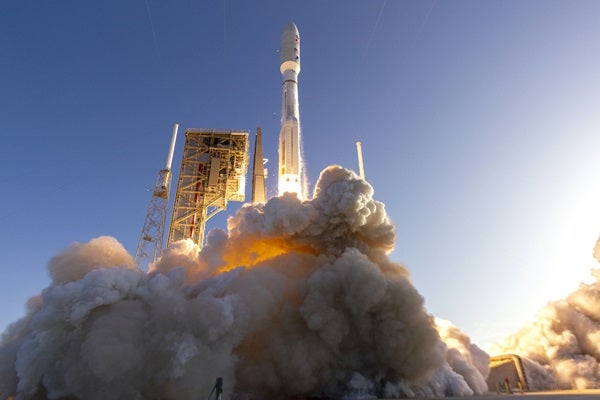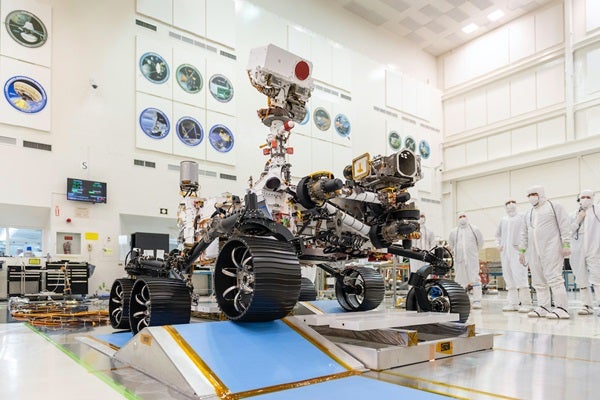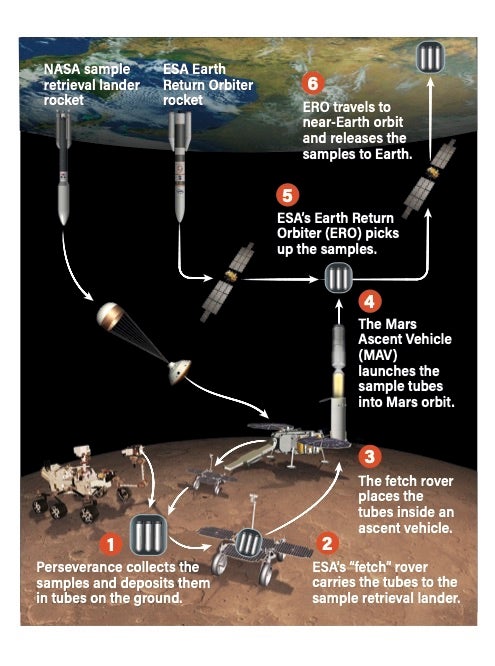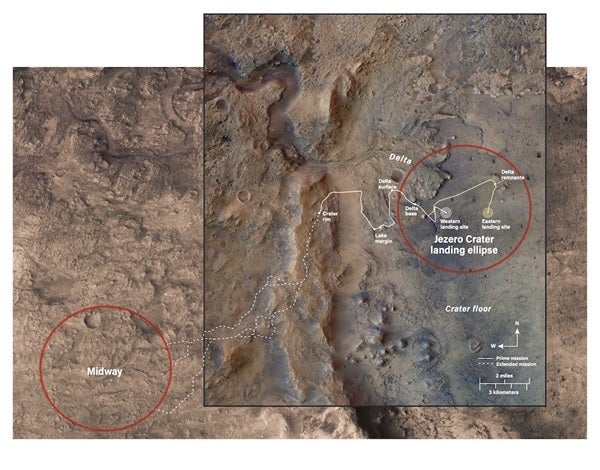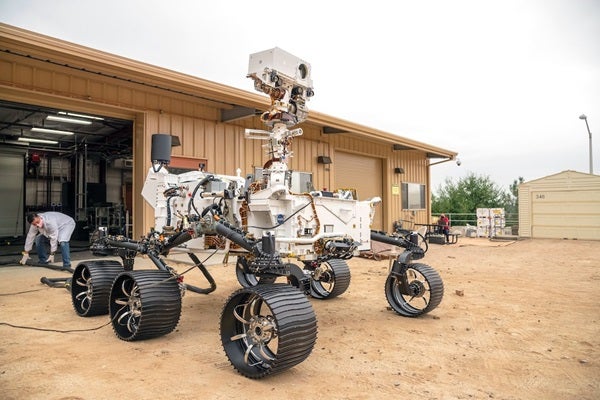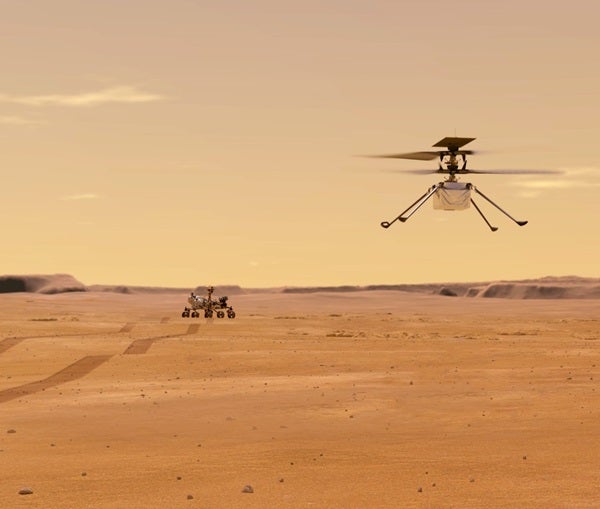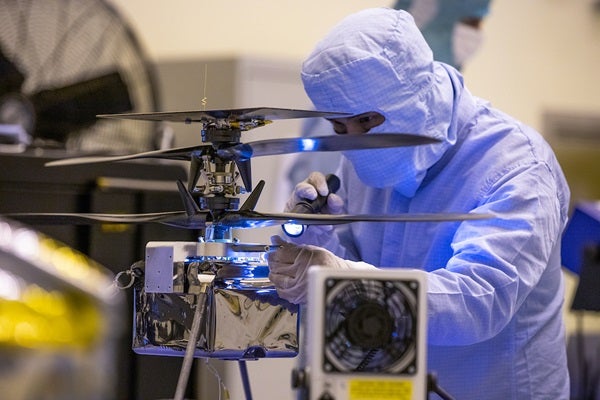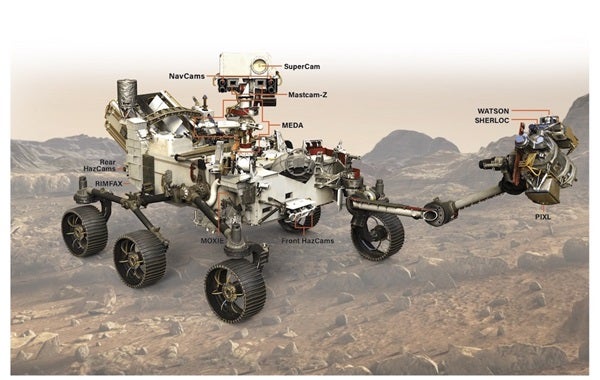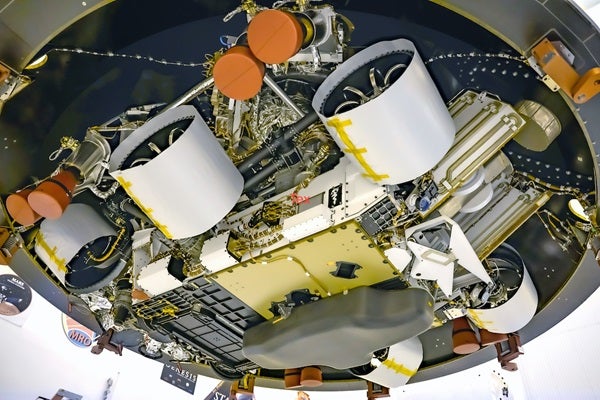The concept of returning samples from Mars has been something of a holy grail for planetary scientists. As intrepid as NASA’s previous robotic explorers have been, their analyses of the rock and soil they rove have always been limited by the equipment they carry. When you ship a rover to Mars, the cost of every extra ounce is colossal. And rover instruments — marvels of engineering though they are — are no substitute for a fully equipped laboratory on Earth.
Now, nine years later, that ambitious journey is about to begin. The Mars 2020 mission launched from Cape Canaveral on July 30, 2020, and is scheduled to land in Jezero Crater on February 18, 2021. If all goes well, the rover will embark on a mission lasting at least a full martian year (equivalent to 687 days on Earth). In addition to its own explorations, it will also collect and cache samples that will later be returned to Earth — revealing the mysteries of that once-habitable place on Mars.
A clone is born
In December 2012, just four months after the Curiosity rover landed on Mars, NASA announced a new wheeled explorer that would address the top goal of the most recent decadal. It was scheduled to launch during a favorable Earth–Mars alignment in 2020. This Mars 2020 rover would be designed and built by a team at NASA’s Jet Propulsion Laboratory (JPL) in Pasadena, California — a team that included many of the engineers, managers, and others who had built Curiosity, as well as previous Mars rovers Sojourner, Spirit, and Opportunity.
To fit NASA’s tight budget and reduce the mission’s complexity, 90 percent of the Mars 2020 rover, cruise stage, and sky crane landing system would be built from spare parts left over from Curiosity. Mars 2020 would thus be a clone, of sorts — looking a lot like Curiosity on the outside, but costing at least $700 million less than Curiosity’s $2.8 billion price tag.
On the inside, however, the Mars 2020 rover would sport some entirely new equipment to help it carry out the sample-caching job the decadal had outlined. The mission’s announcement kicked off what NASA Associate Administrator for Science John Grunsfeld called “seven years of innovation” to develop that equipment, along with some completely new tools. In early 2020, nearing the end of the seven-year sprint, the rover finally received its name: Perseverance.
Mars Sample Return
While no missions have yet been approved or funded, several space agencies around the world are deep in the planning stages for a Mars sample-return mission. For example, NASA and the European Space Agency (ESA) are discussing a concept for joint missions that would find, collect, and return the samples cached by the Perseverance rover. And the Chinese National Space Agency is looking into potential robotic sample-return missions as follow-ons to their Tianwen-1 mission, which launched July 23, 2020, and will land a rover in the Utopia Planitia region of Mars in February 2021.
The NASA/ESA plan as currently envisioned would involve the launch of two missions in 2026. The first is a dedicated NASA lander carrying an ESA-built “fetch” rover and a small rocket known as the Mars Ascent Vehicle (MAV). The fetch rover would collect the cached sample tubes left by Perseverance on Mars’ surface and bring them back to the MAV, placing them inside a soccer ball-sized sample capsule. The MAV would then launch them into Mars orbit, where an ESA Earth-return orbiter — the second launch of 2026 — would be waiting to capture the sample capsule. That orbiter would then depart Mars and return to Earth, jettisoning the capsule for a parachute-assisted landing in the Utah desert in 2031. — J.B.
In search of ancient life
Many of the Mars 2020 mission’s goals are similar to those of previous Mars rover missions, like studying the geology and weather of its field site. However, Perseverance also has a number of new and unique objectives. Perhaps the most important is to seek the signs of ancient life.
Ancient means not focusing on any potential living organisms on the surface of Mars today (which are highly unlikely to exist, given the harsh radiation, low surface pressure, and frigid temperature). Instead, Perseverance will seek evidence of organisms that may have lived billions of years ago, during a time early in Mars’ history when the surface environment was a lot more like Earth’s.
These signs could come in the form of preserved physical or chemical evidence, or textures left imprinted on rocks. Finding these biomarkers, however, is no small task. Geologists have a similar struggle on Earth: Though life began on our planet some 3 billion to 4 billion years ago, back in the Precambrian era, organisms didn’t develop shells or skeletons that could easily leave behind fossil remains until about 550 million years ago.
Among the prime examples of ancient biomarkers on Earth are stromatolites, which are rock and mineral structures built up by coordinated groups of simple single-celled organisms, especially cyanobacteria (formerly called blue-green algae). Finding structures like those in ancient rocks on Mars would be an exciting and potentially profound discovery.
This is one of the main motivations for making Mars 2020 the first step of an international Mars sample-return program. Barring the unambiguous (and unlikely) discovery of biomarkers like fossils, the only way to confirm signs of life might be to bring those samples back to Earth so they can be studied in much greater detail. As Carl Sagan famously noted, “extraordinary claims require extraordinary evidence.”
Mars 2020 also has a number of new experiments that are designed to help engineers develop technology for future robotic and human Mars missions. For example, the rover carries a device designed to extract small amounts of oxygen (O2) by splitting carbon dioxide (CO2) molecules with electricity. Larger systems based on this technology could generate oxygen for future human crews on Mars.
Perhaps Perseverance’s most famous tech demo is a small four-blade helicopter drone named Ingenuity. Early in the mission, engineers will program it to conduct three to five test flights to learn more about operating drones on Mars. On future missions, such drones could serve as scouts or sample delivery systems.
Choosing a target
From 2014 to 2018, NASA and the planetary science community carefully studied options for where to land Perseverance. Just as for previous NASA rover missions, a series of open community workshops brought together scientists, JPL mission engineers, technology experts, and even members of the general public to discuss and debate which site would offer the best chance of accomplishing the mission’s goals.
By the time of the fourth workshop in October 2018, the competition had boiled down to four sites. One option was a return to the Columbia Hills in Gusev Crater, where the Spirit rover had uncovered outcrop rocks with interesting silica-bearing minerals and nodular shapes a decade earlier; some researchers think these are potential biosignatures, as similar features can be found in some places on Earth.
The other three sites all sat within less than 100 kilometers of each other. Two of them, near the famous dark region Syrtis Major, had abundant deposits of clay and carbonate minerals, potentially indicating an ancient habitable environment. The final option was Jezero, a 31-mile-wide (50 kilometers) impact crater on the western margin of Isidis Planitia that hosts clays, carbonates, and a well-exposed ancient river delta.
The workshop participants and Mars 2020 science team ultimately recommended Jezero — named after a small town in the Balkan nation of Bosnia-Herzegovina — as their top choice, and NASA officially chose the site as the winner in November 2018.
Jezero will be among the most challenging martian terrains that NASA has yet attempted to land on. All rover landings sites have to meet certain engineering requirements: close enough to the equator to avoid extreme cold; low enough in elevation that a descending rover’s parachute has thick enough air to grasp; and free enough of large rocks, slopes, and other potential obstacles to avoid crashing into them.
But sites with large rocks and slopes are often some of the most scientifically rewarding landscapes. So, clever engineers from JPL and elsewhere have worked to develop more intelligent software to guide Perseverance’s landing stage to a touchdown in Jezero Crater. One upgrade makes the descent stage more aware of when and where to deploy its parachute. And once the parachute is jettisoned and the rover and descent stage are in powered retrorocket flight, a new hazard-avoidance system helps avoid rocks and other large obstacles, guiding the rover to a height of about 25 feet (7.6 meters) over a safe landing site. Then, the sky crane system — pioneered by Curiosity — lowers the rover to the ground via cables for a soft touchdown.
A crater to explore
When Perseverance takes in the landscape inside Jezero Crater for the first time, it will send back images that show the hills of the crater rim rising 2000 feet above the crater floor. If the rover lands close enough to it, early images could also show the 150- to 350-foot-tall edge of one of the most exciting aspects of Jezero: its beautiful western river delta.
On Earth, deltas are fan-shaped splays of sediments where rivers gently deposit sand and silt, forming layers of sandstone and mudstone that can trap and preserve organic materials. Jezero Crater preserves several deltas along its inner rim, showing that it was clearly a shallow crater lake sometime early in Mars’ history. If life emerged on Mars long ago, evidence of it might be preserved in those delta sediments.
What that lake looked like billions of years ago remains unknown, but there are many possibilities. Perhaps waves were lapping at its shores, around what is now the crater rim. Or, if the climate was too cold for surface water, Jezero may have been a vast frozen expanse, with all the river and delta-building action happening below. It’s tempting to speculate, but instead of making wild guesses, the best recourse is to go there and find out.
A major goal of the mission is to drive the rover up to and perhaps even onto that delta, to search for geologic, mineralogic, and chemical evidence of its past environs. On Earth, different kinds of traces of life can appear in different areas of a river delta depending on the speed of the water that deposits the sediment, the size of the grain particles, and how quickly the sediment builds up. The rover team could try to systematically explore the equivalent of these different zones on Jezero. This strategy could maximize the chances of finding regions where potential biosignatures might be preserved.
If the rover team can successfully get Perseverance completely out of Jezero Crater, just 10 miles (16 kilometers) beyond the western rim lies one of the rejected landing sites, dubbed Midway. It’s also rich with ancient clay and carbonates, but many of those mineral deposits could have been created by groundwater coursing through the rocks, rather than surface water. The chance to explore a very different, but also potentially once very habitable, ancient martian environment as part of an extended mission is an exciting prospect.
Perseverance’s toolkit
NASA selected Perseverance’s scientific payload of six instrument systems in a competition between dozens of proposals that researchers submitted in 2014. The winners include three instruments on the rover’s mast: a pair of panoramic, zoomable 3D cameras called Mastcam-Z; a camera and spectrometer called SuperCam that zaps rocks and soil with a laser to analyze their chemical makeup; and a weather-monitoring station called the Mars Environmental Dynamics Analyzer (MEDA). For the most part, these are enhanced versions of systems on the Curiosity rover. However, in a first, SuperCam includes a high-fidelity microphone designed to record sounds on Mars — either from the instrument and other rover subsystems, or potentially from the winds of Mars itself.
The rover carries three new science investigations as well. A ground-penetrating radar system called the Radar Imager for Mars’ Subsurface Exploration (RIMFAX) will probe underground layers of rock — and potentially water ice. The Planetary Instrument for X-ray Lithochemistry (PIXL) will analyze samples on microscopic scales by focusing a beam of X-rays and taking images of the resulting glow. And an instrument called Scanning Habitable Environments with Raman and Luminescence for Organics and Chemicals (SHERLOC) will put samples under a magnifying glass, so to speak, with a microscopic imaging subsystem called Wide Angle Topographic Sensor for Operations and eNgineering (WATSON). Together, the pair of devices will use an ultraviolet laser and spectrometer to search for biomarkers in organics and minerals. PIXL, SHERLOC, and WATSON are all mounted on the rover’s hefty robotic arm; RIMFAX is mounted to the rover’s lower aft deck.
In addition to its science instruments, Perseverance is outfitted with engineering-focused cameras and other subsystems. These include cameras for basic navigation, as well as front- and rear-mounted cameras for avoiding hazards. There are also seven simple, largely “off-the-shelf” cameras mounted on the rover and the spacecraft stages that will carry it to the surface. These will record images and video of the landing process. And, for the first time, there will be sound to go with it — a microphone will be recording audio during the landing. In all, Perseverance, its descent stage, and the Ingenuity helicopter are loaded with 25 cameras, making it the most photo-capable spacecraft ever sent to the Red Planet. — J.B.
Caching the samples
Of course, Perseverance’s scientific legacy will also depend on the samples it collects for return to Earth. To perform this task, the rover’s designers carved out a significant amount of space for the Sampling and Caching Subsystem (SCS). The SCS drill, mounted on the rover’s arm, will take core samples of martian rock and soil. Its carousel of bits includes six bits for drilling rock core samples, one “regolith” bit for collecting soil, and two abrading bits for grinding rocks or other surfaces for analysis with the rover’s instruments. There’s also a tool that can blow puffs of nitrogen gas onto a sample to remove dust or drill tailings.
The rover also houses a tiny robotic arm that can capture samples delivered into the rover’s body, document them, seal them in titanium tubes, and then drop them onto the surface for later collection and return to Earth. Perseverance is carrying a total of 43 of these dry-erase-marker-sized tubes to Jezero. During the prime mission, the science team hopes to fill up to 38 of them with the most compelling and potentially revealing rock and soil samples as possible.
However, the remaining five are just as critical: They are specifically designed to provide “witness samples” that characterize any organic or other chemical contaminants that might have been brought to Mars from Earth, despite the team’s best efforts at sterilizing the sample tubes. Instead of being filled with samples, they will go through a full “mock coring” process and be handled and sealed by the rover’s SCS systems just like the actual samples. This provides a way to check whether any organic materials or other contaminants coming from the rover itself have been able to sneak into the actual Mars samples, too.
Ready to rove
After several years of design, the rover instruments and subsystems finally began taking shape in 2016. Engineers at JPL assembled the rover in 2019 and put it through extensive tests through the first half of 2020, simulating the harsh thermal conditions on Mars and the vacuum of space.
The final stages of assembly, testing, and installing the craft atop the launch vehicle occurred in the midst of the COVID-19 pandemic. By mid-April, 90 percent of the team at JPL was working from home, but mission-critical personnel were still needed to at the Kennedy Space Center in Florida to prep the rover itself.
Following clean protocols was not a challenge for the team, as those are necessary for preparing any lander to avoid contaminating the worlds they visit. But they improvised to minimize the number of people needed inside the clean room itself. For instance, the final “walkdown” inspection of the spacecraft — in which experts in each spacecraft system give the rover one last check — took place remotely, with a technician in Florida using a smartphone to send a video feed to senior engineers at their homes.
The window for Mars 2020 to actually launch in 2020 ran from July 17 through August 15. If the mission missed that window, it would have had to wait until September 2022. The challenges that the coronavirus presented made the efforts of all involved — including at JPL, NASA’s Kennedy Space Center, United Launch Alliance (the manufacturers of the Atlas V rocket), and other NASA and subcontractor facilities — to make the launch window especially impressive.
The ambitious rover did go over its original 2012 budget — but only by around 12 percent, partly due to delays and issues related to COVID-19. Considering the cost overruns that have plagued many past NASA flagship-class missions, a 12-percent overrun could be considered something of a minor victory.
Now, the anticipation is building. Who knows what discoveries await us all in Jezero, what new secrets about Mars will be revealed by the images and other data the rover will collect. Everyone involved is extremely excited about what we will learn from the rover’s mission on Mars. And many of us are eagerly looking forward to the day when we can see those rover-collected samples — not just through the lenses of our sophisticated robotic avatar, but with our own human eyes.


